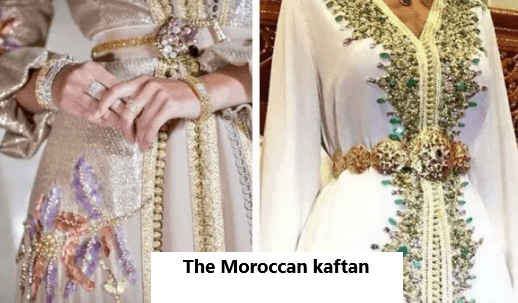The Moroccan kaftan is more than simply an item of apparel—it’s a window into Morocco’s rich social heritage, a custom that goes beyond time. Known for its elaborate designs, elegant textiles, and obvious sophistication, the kaftan has become an international icon of class, appreciated and embraced by fashion lovers and tourists alike.
The History of the Kaftan
The History of the Kaftan
The beginnings of the Moroccan kaftan date back centuries, with chroniclers tracing its origins to the Andalusian period, where it graced the courts of aristocracy and the aristocracy. Presented to Morocco via social exchanges, the kaftan was embraced and transformed into a sign of Moroccan identity and virtuosity.

Initially made for the highest social class, the kaftan was crafted from premium materials such as silk, velour, and brocade. It consisted of thorough needlework, usually in silver or gold string, showcasing high artistry. With time, the kaftan developed, appearing to different social classes while maintaining its luxurious essence.
In contemporary Morocco, the kaftan is central to standard ceremonies, particularly wedding celebrations and religious events like Eid al Fitr and Eid al Adha. Each kaftan tells a unique story, representing the user’s regional impacts and individual preferences.
The Elegance of the Moroccan Kaftan
The Moroccan kaftan is celebrated for its classic sophistication and flexibility. Its streaming shape and comprehensive decorations mkae it suitable for both official occasions and informal gatherings. Regional variations add diversity to its layouts:
- Fez Kaftan: Known for its elaborate gold needlework, showing the city’s royal background.
- Rabat Kaftan: An excellent blend of conventional and modern designs, perfect for modern fashionistas.
- Marrakech Kaftan: Vibrant and vibrant, inspired by desert landscapes and Berber heritage.
The textiles used—including satin, silk, and velvet—are picked for their high quality. At the same time, craftsmen utilize typical strategies like “randa” (hand embroidery) and “sfifa” (knotted trims) to develop stunning layouts. Each kaftan is a masterpiece, embodying the artistry of Moroccan artistry.
The Kaftan on the Global Stage
In recent years, the Moroccan kaftan has captured the interest of international target markets. Its one-of-a-kind blend of practice and modernity has made it a preferred among international icons, containing:
- Princess Diana: Her selection of a kaftan throughout her check out to Morocco in the 1980s elevated the garment’s global condition.
- Beyoncé: The songs superstar showcased the kaftan’s prestige at exclusive events, bringing Moroccan style to the international spotlight.
- Jennifer Lopez: Known for her love of style, Lopez embraced the Moroccan kaftan’s beauty in several top-level appearances.
- Naomi Campbell: The famous supermodel donned a Moroccan kaftan throughout worldwide fashion programs, highlighting its convenience.
These recommendations have made the kaftan a sign of the highest social class, inspiring designers worldwide.
UNESCO Recognition of the Moroccan Kaftan
UNESCO Recognition of the Moroccan Kaftan
In 2021, UNESCO officially acknowledged the Moroccan kaftan as part of the Intangible Cultural Heritage of Humanity. This acknowledgment celebrates the kaftan’s social and artistic value and highlights the value of protecting this heritage.
In 2025, UNESCO decided that the Moroccan caftan is a Moroccan heritage.
The acknowledgment has also accentuated the skilled artisans who continue to craft kaftans using standard methods. By sustaining these craftspeople, Morocco guarantees the survival of this legendary social icon for future generations.
Why Tourists Love the Moroccan Kaftan
In 2021, UNESCO officially acknowledged the Moroccan kaftan as part of the Intangible Cultural Heritage of Humanity. This acknowledgment celebrates the kaftan’s social and artistic value and highlights the value of protecting this heritage.
In 2025, UNESCO decided that the Moroccan caftan is a Moroccan heritage.
The acknowledgment has also accentuated the skilled artisans who continue to craft kaftans using standard methods. By sustaining these craftspeople, Morocco guarantees the survival of this legendary social icon for future generations.
Conclusion
The Moroccan kaftan is a true personification of Morocco’s social splendor and imaginative ingenuity. From its historical beginnings to its modern-day global appeal, the kaftan continues to astound and influence. For vacationers, it represents a garment and a site to recognize Morocco’s customs, values, and virtuosity.
Links and Sources:
- UNESCO Intangible Cultural Heritage
- Discover Moroccan Fashion
- The History of the Moroccan Kaftan
- Traditional Moroccan Weddings



